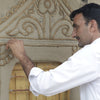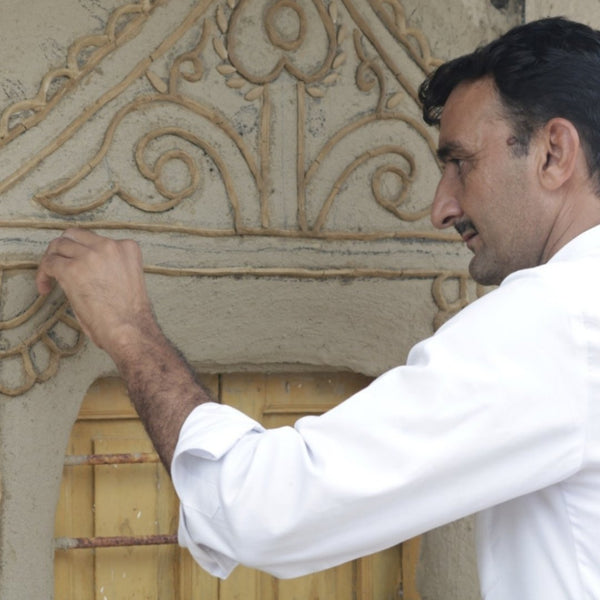Lippan
Kaam
Lippan art, also known as Mud and Mirror work, is a traditional Indian craft that has its roots in the desert region of Kutch, in the state of Gujarat. This unique art form involves intricate designs created using a combination of clay and mirror pieces, resulting in beautiful decorative patterns that adorn walls and other surfaces.
History and Tradition of Lippan Art
The tradition of Lippan art in India dates back several centuries, with its exact origins shrouded in mystery. It is believed to have emerged among the Rabari community, a nomadic pastoralist group in Gujarat. Lippan art was traditionally used to decorate the walls of Bhungas, circular mud huts typical of Kutch architecture. These intricate designs not only served an aesthetic purpose but also had symbolic meanings, often reflecting themes related to nature, animals, and daily life. The inclusion of mirrors in the designs is thought to have both practical and spiritual significance, reflecting light and warding off evil spirits.
Legend
According to local legend, the use of mirrors in Lippan art has its origins in a mystical story. It is said that a young shepherd once found a piece of broken mirror in the desert and used it to decorate his hut. When the sunlight reflected off the mirror, it illuminated the surrounding area, attracting the attention of the local community. This led to the integration of mirrors into traditional mud designs, giving rise to the unique aesthetic that is now synonymous with Lippan art.
Technique and Details
The technique of Lippan art involves creating intricate patterns using a mixture of mud and camel dung, which serves as the base material. The process begins with preparing the even mud wall or panel surface where designs are outlined with thin threads or chalk. The artisans apply a mixture of clay and camel dung to create raised patterns or designs, with the mirrors serving as focal points within the patterns. Once the design is complete, the mud is allowed to dry and harden, resulting in a durable and visually stunning artwork. The primary characteristic of Lippan art is the use of mirrors, which are cut into various shapes and embedded into the mud designs. The designs often feature geometric shapes, floral motifs, animal figures, and traditional symbols. Some of the notable Lippan artisans are Nalemitha, Majikhan, and Hafiz Mutva, amongst others.
FAQS
How do I care for Lippan art pieces?
To care for Lippan art pieces, especially if they are made on movable surfaces like wood or canvas, keep them away from direct sunlight and moisture to prevent damage. Dust the artwork gently with a soft cloth to maintain its appearance. For wall-mounted Lippan art, regular dusting and avoiding contact with water will help preserve its beauty.
Is Lippan art environmentally friendly?
Yes, Lippan art is environmentally friendly, as it uses natural materials like clay, cow dung, and mirrors. The traditional methods of making Lippan art are sustainable and have minimal impact on the environment.
Can Lippan art be customized?
Yes, Lippan art can be customized according to your preferences. You can work with MeMeraki team to choose specific patterns, colors, and sizes that suit your space. Custom Lippan art pieces can be tailored to reflect personal tastes while maintaining the traditional essence of the craft.
How long does it take to create a Lippan art piece?
The time required to create a Lippan art piece depends on the complexity of the design and the size of the area being decorated. Simple designs may take a few days, while more intricate and larger works can take several weeks to complete.
Is Lippan art suitable for modern interiors?
Yes, Lippan art has been adapted to suit modern interiors while retaining its traditional charm. It can be used as a statement piece in contemporary homes, adding a touch of ethnic elegance and cultural richness to any space.
What are the materials used in Lippan Kaam?
The primary materials used in Lippan Kaam are:
Mud: This forms the base of the artwork.
Cow dung: It acts as a binder and helps to strengthen the mud mixture.
Sand: It adds texture and durability to the artwork.
Natural pigments: These are used to create colorful designs and patterns.
What are the common themes and motifs in Lippan Kaam?
Lippan Kaam often features geometric patterns inspired by nature, such as flowers, leaves, and animals. Religious motifs, especially those related to Hinduism, are also common.
![]() Get Upto 10% OFF on purchase of this product.
Get Upto 10% OFF on purchase of this product.
![]() Get upto 10% OFF on Live Workshops when sign up for 2 or more workshops.
Get upto 10% OFF on Live Workshops when sign up for 2 or more workshops.
![]() Get 10% OFF coupon code for Art Kits signing up for Masterclass or Live Workshop.
Get 10% OFF coupon code for Art Kits signing up for Masterclass or Live Workshop.
![]() Earn upto 3,000 Points on purchase of this product.
Earn upto 3,000 Points on purchase of this product.





